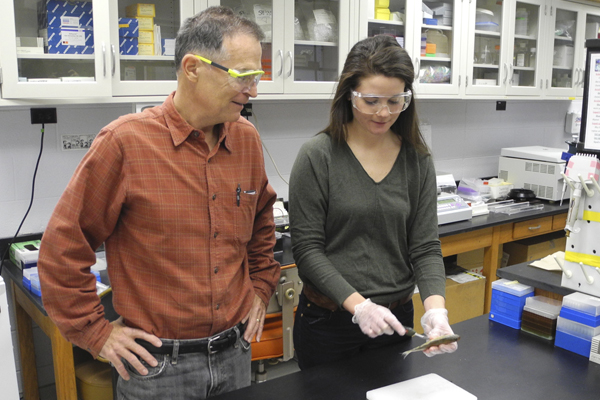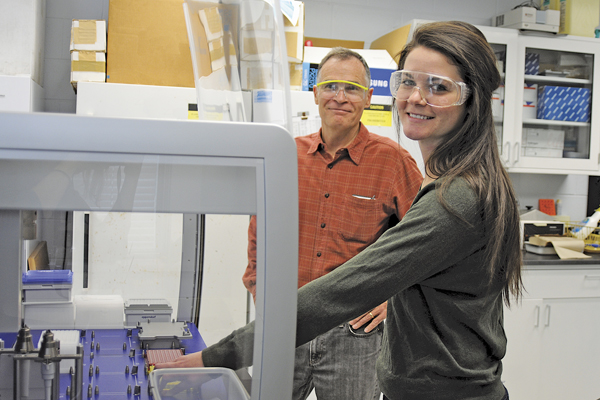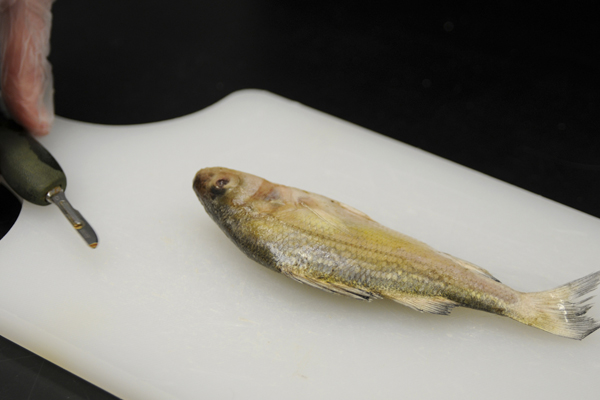


Finding a safe perch
New research on white perch has implications for consumption advisories
8:59 a.m., May 28, 2013--White perch are a popular catch in the Delaware River and Delaware Bay, but contaminants can make the fish unsafe to eat. Officials advise against eating white perch caught north of the Chesapeake and Delaware Canal and limiting consumption of those from south of the canal.
The trouble is, the fish can swim through that border.
Research Stories
Chronic wounds
Prof. Heck's legacy
“That’s just a rough guideline,” said Patrick Gaffney, professor of marine biosciences in the University of Delaware’s College of Earth, Ocean, and Environment. “It doesn’t really take into account the fact that there may be some populations that are really free of contaminants and others that are not.”
Gaffney and recent graduate Megan Shaffer have been working to identify distinct subpopulations of white perch in the Delaware Bay Estuary using genetic techniques. The different groups may vary in toxin levels depending on where they travel — and possibly be safer to eat than current advisories indicate.
Over the past year Shaffer prepared and analyzed dozens of fish samples provided by the Delaware Department of Natural Resources and Environmental Control (DNREC) from several locations to look for patterns in their genetic makeup.
“You can see if they’re similar in locations or different,” said Shaffer, who used the research as the basis of her senior thesis and graduated summa cum laude on Saturday, May 25, with a bachelor’s degree in biology and a minor in marine studies.
Her data combined with Gaffney’s earlier results show that the population structure is geographically linked. Using DNA sequences, the researchers can tell that fish from different areas of the estuary, say the Broadkill River or St. Jones River, are distinct. By looking at patterns of variations and differences between the samples, the scientists can infer how much migration there is between groups of fish.
Complicating matters, white perch reproduce in freshwater but some parts of the population migrate down into Delaware Bay. The scientists are trying to determine whether fish in the bay come from nearby tributaries or inhabit different parts of the bay.
They suspect that Delaware Bay has multiple isolated sub-populations of white perch, with water salinity levels acting as barriers to gene flow among them.
Natural resource managers are particularly interested in how the fish differ from place to place and whether they contain the harmful environmental pollutants polychlorinated biphenyls (PCBs). If there is a tributary with PCBs in the creek from development or industry, then the fish that spend their lives there will contain higher levels of the toxins.
The work will not redefine the consumption advisories for DNREC, which has already spent considerable effort ensuring the public is safe, Gaffney said, but rather could make warnings more specific in the future.
“Our hope is to have them use this information to work towards maybe making more complicated but useful consumption advisories that would allow them to maintain minimum public health risk yet allow people to continue enjoying the resource,” Gaffney said.
Shaffer’s involvement in the project was supported by a grant from the Delaware Sea Grant College Program, and she plans to work as lab technician after graduating and eventually apply to graduate school — after volunteering in Greece this summer to assist a sea turtle protection organization.
Her experience at UD gave her a taste of what graduate school would be like: she participated in the Semester-in-Residence Program at Hugh R. Sharp Campus in Lewes taking graduate-level classes and spending time in the field. She also spent several weeks on a cruise to hydrothermal vents in the Atlantic last fall, worked as a UD-WATER intern on a stormwater management project and took advantage of expanding CEOE offerings for undergraduates in marine science.
“Megan’s been a forerunner,” Gaffney said. “They should all be such good students!”
About the Delaware Sea Grant College Program
The University of Delaware was designated as the nation’s ninth Sea Grant College in 1976 to promote the wise use, conservation and management of marine and coastal resources through high-quality research, education and outreach activities that benefit the public and the environment. UD’s College of Earth, Ocean, and Environment administers the program, which conducts research in priority areas ranging from coastal hazards to seafood safety.
Article by Teresa Messmore
Photos by Lisa Tossey










